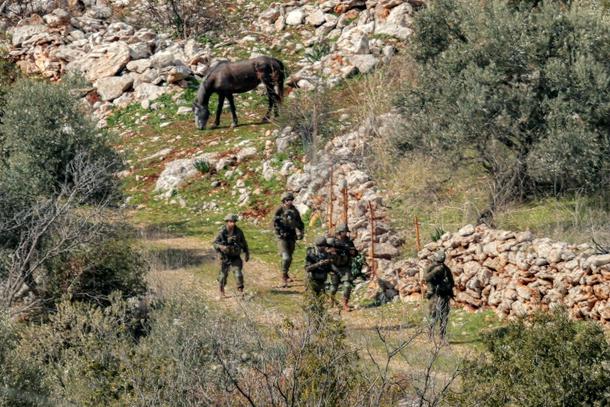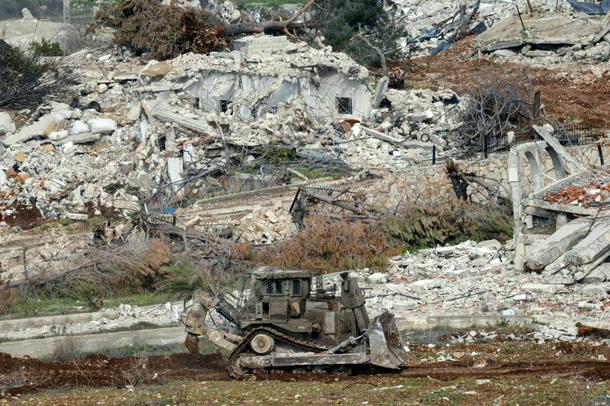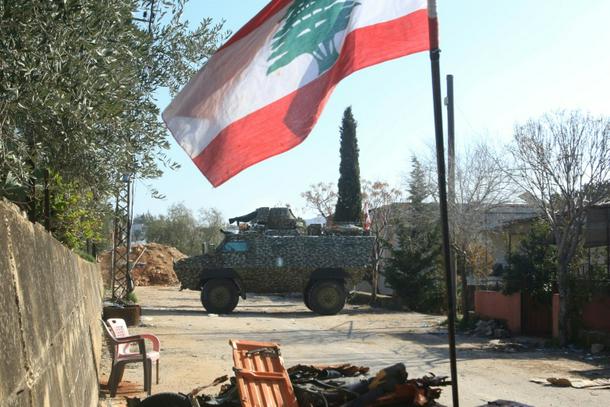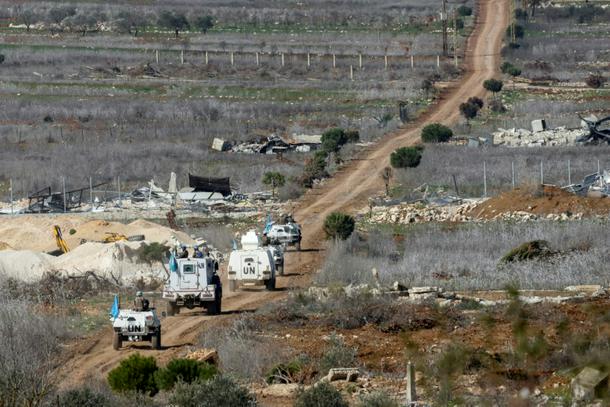
Israeli army forces patrol in the village of Kfarshuba in southern Lebanon on February 17, 2025
Beirut (Lebanon) (AFP) - Israel’s army has pulled out of southern Lebanese villages but remains in five positions, as a delayed withdrawal deadline expired Tuesday under a ceasefire deal with Hezbollah.
The ceasefire between Israel and the Iran-backed militant group has been in effect since November 27, following more than a year of hostilities, including two months of all-out war in which Israel launched ground operations.
Israel had announced hours before the pullout deadline that it would keep troops in “five strategic points” near the border, and on Tuesday its defence minister, Israel Katz, confirmed the deployment and vowed action against any “violation” by Hezbollah.
A Lebanese security source earlier told AFP that “the Israeli army has withdrawn from all border villages except for five points.”
Lebanon’s army announced it had deployed in southern border villages and areas from which Israeli troops have pulled.
Hezbollah strongholds in south and east Lebanon as well as Beirut suffered heavy destruction during the of cross-border hostilities.
Hezbollah launched the attacks in support of ally Hamas, at war with Israel in the Gaza Strip since the Palestinian militant group’s October 7, 2023 attack.
The Israel-Hezbollah conflict killed thousands in Lebanon and dozens in Israel, displaced tens of thousands on both sides and decimated the armed movement’s leadership.
In Lebanon, the cost of reconstruction is expected to reach more than $10 billion, while more than 100,000 people remain displaced, according to the United Nations.

An Israeli military excavator drives past destroyed houses in the Lebanese village of Dhayra near the border with northern Israel, on February 17, 2025
Despite the devastation, thousands of those uprooted by the conflict have been waiting to return home, inspect their properties and in some cases search for the remains of loved ones.
“I miss sitting in front of my house, near my roses and having a morning cup of coffee,” said Fatima Shukeir, in her 60s, who planned to return to her border village after more than a year and a half of displacement.
“I miss everything in Mais al-Jabal, I miss my neighbours. We were separated and I don’t know where they went,” Shukeir said.
Several border towns and villages, including Mais al-Jabal’s municipality, have called on displaced residents to wait for the Lebanese army to deploy there before coming back, so as to guarantee their “safe” return.
Lebanese television channel LBCI reported Tuesday that the country’s army had moved overnight into Mais al-Jabal, Blida, Yaroun, Maroun and Mahbib.
- ‘Lost young people’ -
Under the ceasefire, brokered by Washington and Paris, Lebanon’s military was to deploy alongside United Nations peacekeepers as the Israeli army withdrew over a 60-day period that was extended to February 18.

Lebanese army soldiers guard the entrance of the southern Lebanese village of Houla on February 17, 2025
Hezbollah was to pull back north of the Litani River, about 30 kilometres (20 miles) from the border, and dismantle remaining military infrastructure there.
Israel’s military said late Monday it would remain temporarily “in five strategic points” dotted along the length of the shared border in order to “continue to defend our residents and to make sure there’s no immediate threat”.
Lebanese authorities have rejected any further extension of the withdrawal period, urging sponsors of the deal to pressure Israel to pull out.
Prime Minister Benjamin Netanyahu said Sunday that Israel would do what it has to in order to “enforce” the ceasefire.
“Hezbollah must be disarmed,” he added.
Despite the destruction in the border area, Shukeir said she was eager to return home.
“We’ll go to our town and be happy (again), despite the fact that our homes have been destroyed and we lost young people,” she said.

A convoy of United Nations Interim Force in Lebanon (UNIFIL) drives near the southern Lebanese village of Blida, on February 17, 2025
On Monday, Ramzi Kaiss from Human Rights Watch said “Israel’s deliberate demolition of civilian homes and infrastructure” was making it “impossible for many residents to return”.
Since the cross-border hostilities began in October 2023, more than 4,000 people have been killed in Lebanon, according to the health ministry.
On the Israeli side of the border, 78 people including soldiers have been killed, according to an AFP tally based on official figures, with an additional 56 troops dead in southern Lebanon during the ground offensive.
Around 60 people have reportedly been killed since the truce began, two dozen of them on January 26 as residents tried to return to border towns on the initial withdrawal deadline.
On Monday, Lebanon’s government said the state should be the sole bearer of arms, in a thinly veiled message on Hezbollah’s arsenal.
Calls for the Iran-backed group’s disarmament have multiplied since the end of the war that has weakened the group.